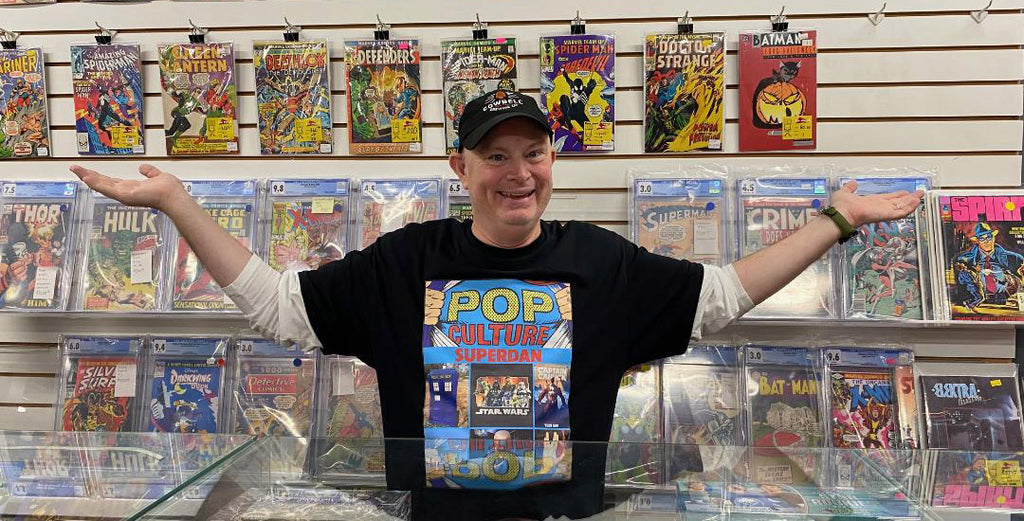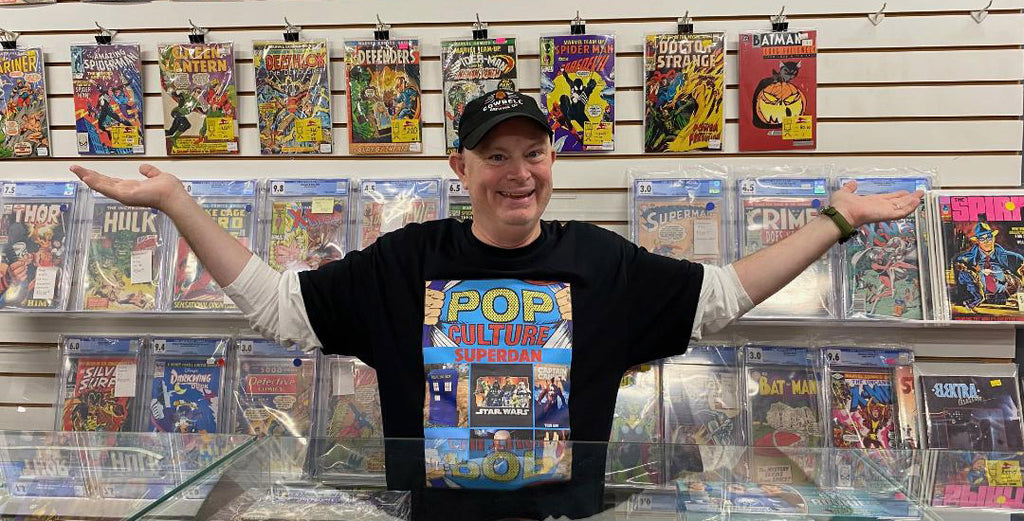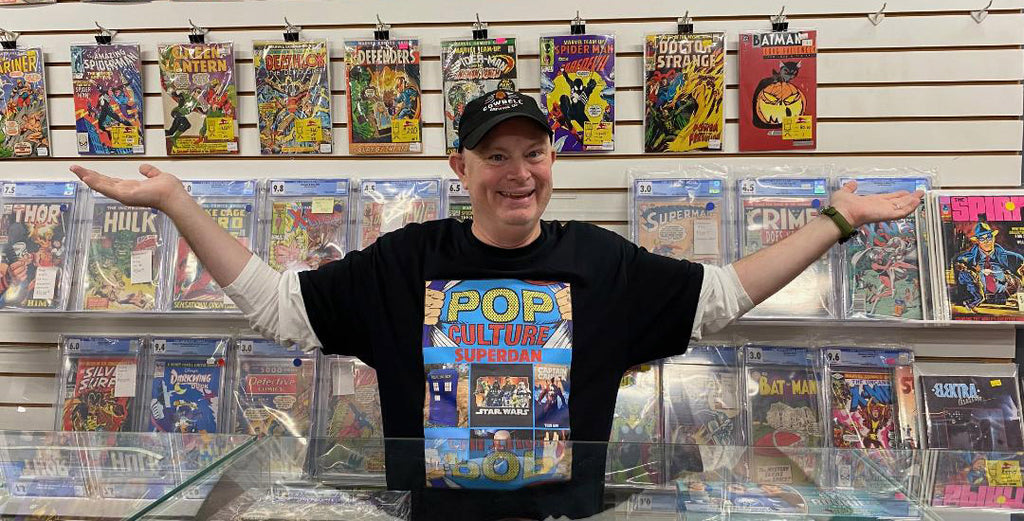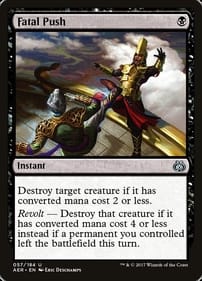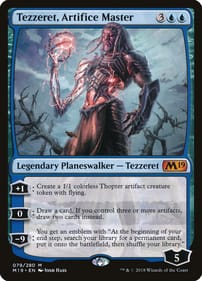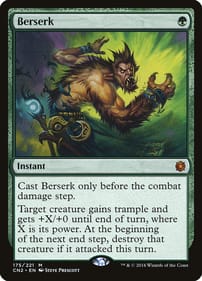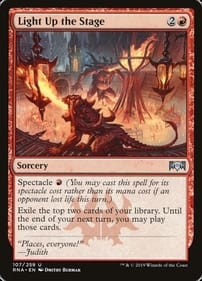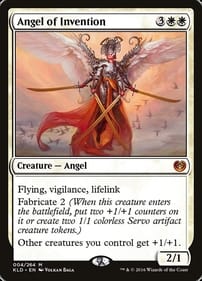Man, I Miss WKRP
By Dan Brown Loni Anderson died last week, and I felt a pang. It’s the same flutter of emotion I feel whenever I think about the long-gone CBS series WKRP in Cincinnati. Along with Match Game and the Muppet Show, WKRP was one of my favourite TV shows from the 1970s, and of all time. I miss it. Anderson rose to fame on WKRP as receptionist Jennifer Marlowe. The series was a workplace sitcom that elevated the workplace sitcom with realistic performances and superlative writing, but was mostly ignored by the television-watching public. Anderson played Marlowe not as the obvious ditzy blond, but as possibly the smartest person at the fictional radio station whose poise came from a wealth of self-knowledge. Jennifer knew who she was, and she was more complex than she looked – the stacked bombshell with the million-watt smile who lit up the lobby, prey for the visiting salesmen who always hit on her. She was one of the reasons I fell in love with the show, which I watched in afternoon reruns following classes when I was at elementary school. WKRP stood out from the other after-school offerings like The Edge of Night and Sanford and Son because the characters were multi-dimensional, and the way they viewed the world – as reflected in the funny lines they spouted – made sense to my developing mind. Also appearing were characters like world-weary morning man Dr. Johnny Fever, mellow evening host Venus Flytrap, ambitious program director Andy Travis, clueless station manager Arthur “Big Guy” Carlson, lecherous salesman Herb Tarlek, over-serious news director Les Nessman, and earnest cub reporter Bailey Quarters. Originally intended to revolve around Travis, the show grew into an ensemble piece that ran from 1978 to 1982, straddling the brief Carter Era as it gave way to the Reagan Years. I always considered it a tragic injustice that WKRP never got a proper series finale, although there wasn’t as strong a tradition of them back then as today. Individual episodes were based on actual personalities and situations that creator Hugh Wilson had come across in his own broadcasting career. The background tunes that viewers heard were real radio staples or hits-in-the-making. I remember the show clearly because the writers did an amazing job of doling out small details about each of the characters in an organic way. Viewers learned Jennifer liked to date older, rich men, and there was at least one episode dedicated to scratching below the surface of this seeming lust for gold. Another had her small-town boyfriend arriving in Cincinnati to drag her by the hair back to Rock Throw, West Virginia. One episode had a union drive sweeping the station. A co-worker asked if she would be joining. "I already belong to a union,” she educated her interlocutor. “It's a quasi-religious group called the International Sisterhood of Blond Receptionists. There are only 12 members in the world. We meet once every two years in Switzerland. If I told you our minimum salary you'd have a heart attack and die. Bye." In yet another, she had to witness and carry out the videotaped last wishes of her former lover, over his family’s objections – naturally, they assumed she was after the admiral’s money. It ended not with all the plot threads being tied in a tight bow, but with no resolution at all, the situation promising to persist. That kind of realism was rare on TV in those days. WKRP also played an important role in the history of television. It continued in the imprint of The Mary Tyler Moore Show, exploring the antics behind the scenes at a broadcasting outlet, while pointing toward future programs that would continue in the same vein, such as The Larry Sanders Show. Being a huge fan still, I’m always looking for excuses to write about it. So when I was at the National Post in 1998, I penned an article marking the 20th anniversary of the show’s debut. I was able to get a hold of cast members Gordon Jump (Carlson), Tim Reid (Flytrap), and Gary Sandy (Travis) for interviews. It’s one of the great disappointments of my career that I wasn’t able to reach Anderson. If she was half as intelligent as Jennifer Marlowe, I’m sure talking with her about the role that made her famous would have been a rare treat. NOTE: I’ll be taking a break from column-writing for the next two weeks, returning to my regular posting the week of Sept. 1. Dan Brown has covered pop culture for more than 32 years as a journalist and also moderates L.A. Mood’s monthly graphic-novel group.
Memories of Call the Office
By Dan Brown It’s every Londoner’s birthright to rock out at Call the Office. And now it looks like a new generation of Forest City youth will get to exercise their birthright. According to a report in the London Free Press, the seedy watering hole — where I spent many a night in my teens and early 20s -- is to be reopened after the bigwigs at City Hall sign off on renovation plans. I call that a good-news story. As you may have guessed, I’m a Call the Office fan from way back. It looms large in my memory. I may have seen Iggy Pop at Kipling’s, Meatloaf at Dr. Rockit’s, KoKo Taylor at the Other Side of Five, and Cowboy Junkies at Centennial Hall, but it was Call the Office where I witnessed more live music than at any other joint downtown. The Legend Killers always put on a memorable show. Hopping Penguins raised the roof many a sweaty evening. And the Bourbon Tabernacle Choir was a guaranteed good time. There’s something about dive bars that naturally attracts young men (you will be unsurprised to learn I was reading a lot of Charles Bukowski in those days). Oh, and for the record, the proper nickname is “Call the O,” not “the Office,” even if the latter led to many unintentionally funny exchanges along these lines: Female acquaintance: “Where’s Dan tonight?”Male friend: “He’s at the Office.”Female acquaintance: “Wow, I didn’t even know he had an office job. He’s always working.” If you read the same Norm De Bono article, you’ll have heard the dormant bar’s owner has plans to put in a rehearsal space upstairs, an elevator, maybe even a washroom fit for human use. It won’t be the same. And that’s OK. I’m sure there is enough residual magic still sprinkled around the former York Hotel, which has been shuttered since pandemic times, to light up the stage. What do I see in my memories? There was that one bouncer who looked like John Belushi. He was awesome. And then the other bouncer who had the same haircut as Don Henley on the cover of End of the Innocence. There were street creatures we saw only at Call the Office. One, my drinking buddies and I nicknamed That Drunk Guy because, well, he was perpetually hammered. There was also Tall Alternative Guy and a whole crew of players in a drama playing only in our shared imagination. We saw them nowhere else. And yes, we sweated it out at shows featuring every future Canadian headliner: Crash Test Dummies, the Tragically Hip, Rhetostatics, you name it. I guess that’s what people are referring to as the Cassette Era now. Little did I know, but future friends like Gord Mood were at some of those same concerts. Nor do I know where we got the cash for all those Labatt 50s, which among our group of friends was called “Stinky.” You would put a loonie down on the pool table and if you and your partner had the magic touch, you could ride it all night. We also saw the Phantoms, which was rumoured to be a former Doors cover band. During my reggae phase, we saw Lazo and Satallites multiple times. And when the Gruesomes came through London on their farewell tour, I saw them at the Friday-night show, then came back for the Saturday-night show as well. Their bop I Need You still rings in my ears. One time one of the Ramones was scheduled to play, but the show was cancelled when he couldn’t get over the border. We stewed on the patio, drinking our cold bottles of Stinky. My Strathroy District Collegiate Institute classmate Tom Nesbitt was the lead singer for the Others, and their version of Gordon Lightfoot’s Sundown inhabits a special place in one corner of my mind. White Punks on Funk seemed to be the house band, along with mainstays Julia Propeller. Those evenings generally went like this: Me and my buddies would go to GTs for what we called First Call, then stopped at the Wick for cheap draft before heading across York Street to our destination. The fun began in earnest when the band hit the stage. Now a new day is dawning for Call the Office and a younger generation will make memories of their own in the same spot where I came of age. I hope you have fun, kids! Dan Brown has covered pop culture for more than 32 years as a journalist and also moderates L.A. Mood’s monthly graphic-novel group.
Looking Back at 2024: The Year in Comics
By Dan Brown It’s time to go over the last 12 months in comics to pick out the highlights. These categories are arbitrary, the choices are mine alone, and I invite you to chime in with your own selections! Best graphic novel of year: This goes to Walter Scott’s The Wendy Award, the latest chapter in the story of everyone’s favourite anxiety-ridden, coke-snorting young artist. It ends with Wendy, an MFA graduate from the University of Hell (i.e. Guelph), possibly turning her back on the world of art. Say it ain’t so! Best debut graphic novel of the year: I give this one to Maurice Vellekoop’s I’m So Glad We Had This Time Together, his memoir of growing up gay in Toronto as the son of strict Dutch immigrants. His lines are lively, and they evoke Seth’s work for me. Best local graphic novel: You gotta love the Curly Head Ballet from Doug Rogers, the only comic I know that was inspired by London’s Original Kids Theatre. It’s a trip! Barbenheimer of my summer: Montreal cartoonist (and Western Gazette alum) Gabrielle Drolet’s rat character went on vacation in Europe in the warmer months, as Drolet herself went on a parallel journey. Daily deadlines were no obstacle for the artist, and I hope she assembles these strips into an anthology. If the folks at Montreal’s Drawn & Quarterly are as smart as I think they are, they’ll be the ones to publish it! Anniversary of the year: Goes not to a superhero, but to a giant lizard with the ability to breath nuclear fire! I’m talking about Godzilla, the kaiju who in November marked 70 years since his first movie appearance. Oh, no! They say he’s got to go! Go, go, Godzila! Comic villain of the year: I’m giving this one to a flesh-and-blood person, not a comic baddie. A big boo to sometime footballer Colin Kaeprnick for his idea to create a company, Lumi, that aims to replace the talented humans who make comics with AI-created work. Way to cheese off an entire industry! It’s about time: The winner in this category is Canada Post, which issued a series of stamps this year to recognize homegrown graphic novelists such as Chester Brown and the Tamaki cousins. Finally! Better never than late: Marvel Comics might have had a better year if they hadn’t belatedly given Roy Thomas a credit as one of the character Wolverine’s creators, a move which antagonized fans and likely made no one happy apart from the former Marvel editor himself. Least surprising plot twist of the year: Speaking of Marvel, I understand that the Krakoa phase of the X-Men’s history has ended, with our favourite band of mutants returning to mainstream society – thus confirming that as long as a comic sells, any change is temporary. Burgeoning trend of the year: Actor Elliott Page used a pop-culture con, the Calgary Expo, to speak out about the Alberta government’s policies on trans youth. Are we seeing cons become platforms for celebrities to speak out on issues? Something I’ll be watching for in 2025. Say what? of the year: Easily won by Marvel Studios, who used San Diego’s Comic-Con International to announce Robert Downey Jr. is returning to the Marvel Cinematic Universe in a suit of specialized armour, only this time he won’t be playing Iron Man, he’ll be . . . Doctor Doom? “New mask, same task,” the popular actor enigmatically pronounced from the con’s stage. Non-news event of the year; At the same event, Marvel competitor DC had an announcement of its own: The company is changing its logo back to the one it used to slap on comics in the 1980s. Yay? Cause for concern: In snippets of footage from the upcoming Fantastic Four film, Pedro Pascal as Reed Richards still has that damn moustache. Not a good sign. Dearly departed: John Cassaday, Trina Robbins, Greg Hildebrandt and Ed Piskor are among the talented individuals who left us this year. Comic journalist of the year: Eisner Award nominee Rob Salkowitz, who writes about comics for publications like Forbes and Publishers Weekly, was a must-read in 2024. I also finally got around this year to reading Salkowitz’s book Comic-Con and the Business of Pop Culture, which I greatly enjoyed. Person of the year in comics: It’s a tie between Ryan Reynolds and Hugh Jackman, who with their $1.3 billion-grossing Deadpool & Wolverine stopped superhero movies from their downward slide with a huge dose of fan service. We’ll find out in 2025 whether it’s a temporary pause or not. And now I wanna hear from you! What were the year’s comic highlights for you? Let me know in the comment box below. Dan Brown has covered pop culture for more than 32 years as a journalist and also moderates L.A. Mood’s monthly graphic-novel group.
Dan Brown's Graphic-novel Gift Guide
By Dan BrownThe holidays are looming, and you’ve been racking your brains for ideas of what gifts to get your family and friends, but coming up short.Well, you’ve come to the right place.We are now at the point where there is a graphic novel for everyone on your list, so please consider the following suggestions as you do your Christmas shopping.For your husband/boyfriend: Any Tintin adventure by HergeFor your wife/girlfriend: Jillian Tamaki’s Super Mutant Magic AcademyFor your dad: Giant by MikaelFor your mom: Any collection of Peanuts comic strips by Charles SchulzFor your brother: Essex County by Jeff LemireFor your sister: Jonathan Dyck’s ShelterbeltsFor your young son: Any Geronimo Stilton graphic novel by Elisabetta DamiFor your young daughter: The Bad Guys Book 1 by Aaron BlabeyFor your best friend: Petals by Gustavo BorgesFor the Marvel fan in your life: Origins of Marvel Comics (the 2024 Deluxe Edition)For the DC fan: Irredeemable by Mark Waid, Peter Krause and Diego BarretoFor the person in your life who loves superhero movies: Robot Dreams by Sara VaronFor the person who hates superhero movies: Ghost World by Daniel ClowesFor the music fan in your life: Leonard Cohen: On a Wire by Philippe Girard For the history buff in your life: Fax From Sarajevo by Joe KubertFor the hockey fan in your life: Essex County by Jeff LemireFor the journalist in your life: Ten Days in a Mad-House: A Graphic Adaptation by Brad RiccaFor the photographer in your life: Weegee from Wauter Mannaert and Max de Radigues For the comics historian in your life: Brian Doherty’s Dirty Pictures (it’s prose)For the lover of newspaper cartoons: Joe Ollmann’s Fictional FatherFor the fan of CanCon: Are You Willing to Die for the Cause? by Chris Oliveros For the grad student in your life: Any of the Wendy titles from Walter ScottFor the theatre lover: Kill Shakespeare by Conor McCreery, Anthony Del Col and Andy Belanger For the lover of literature: Slaughterhouse-Five: The Graphic Novel adapted by Ryan North and Albert MonteysFor the fan of the 1970s: Mimi Pond’s Over EasyFor the fan of the 1980s: Duran Duran, Imelda Marcos and Me by Lorina MapaFor the fan of AI: The Wild Robot by Peter BrownFor the deep thinker in your life: Leslie Stein’s I Know You RiderFor the Muppet fan in your life: A Tale of Sand from Jim Henson and Ramon PerezFor the comics newbie: Either The Dark Knight Returns (Frank Miller) Watchmen (Alan Moore and Dave Gibbons) or The Complete Maus (Art Spiegelman)For just about everyone: Oh, the Places You’ll Go! by Dr. SeussIf you have any of your own gift suggestions, I’d love to hear them in the comment box below! Alternatively, what titles are you asking Santa Claus to leave under your tree? Dan Brown has covered pop culture for more than 32 years as a journalist and also moderates L.A. Mood’s monthly graphic-novel group.
Is There Product Placement in Comics?
By Dan BrownMaybe it’s because I’m a naive fool, but I don’t ever remember seeing an instance of flagrant product placement in a comic book.I’m talking about the classic kind of product placement, the same type you see in movies or on TV where products are written into the plot of the show in return for brand exposure.(I’ll get to advertising partnerships in comics in a minute. They are a different animal.)For example, in an old episode of Big Bang Theory Raj gets a new iPhone. We know it’s an iPhone because after he and Howard unwrap the device, Raj has a conversation with Siri, Apple’s digital assistant. Not very subtle.Product placement like this would in theory be easy to do in comics. The reference could be written into a comic’s script and then the brand’s product would be drawn by the penciller.We all know Wolverine – being Canadian – loves beer, right? So in a scene in which the deadly mutant walks into a bar, he could order a Budweiser or other brand, and the artist could reproduce the label on the bottle or can in Logan’s hand. Easy-peasy, providing you can get the creative team on board with the idea.As straightforward as the process would be, it doesn’t seem to happen much. Maybe I’ve got feeble eyes, but I don’t recall much along those lines taking place in Marvel or DC Comics. There are opportunities aplenty, it’s true.Batman’s alter ego, Bruce Wayne, might prefer a certain make of sports car. Ben Grimm could make his preferences known for a specific type of cigar. Photographers love to talk about the equipment they favour, so why would Peter Parker be any different?The argument in favour of product placement in comics might go something like this: “We live in a world of brands, so superheroes having brand preferences would make them and their milieu seem more realistic. If advertisers want the exposure, publishers could use the extra revenue.”I’m talking solely about comics here. I know there’s plenty of product placement in motion pictures that feature the same superheroes. That’s a whole other column.Nor am I talking about the advertising partnerships comic publishers occasionally embark on, which are embarrassing because they’re so blatant.For example, Marvel characters such as the Hulk and Spidey were loaned out to Hostess in the 1970s to go on adventures in which the villains were all defeated or distracted the same way: By being fed Twinkies. These appeared as clearly marked ads, not part of a comic's storyline.Likewise, about a decade ago, motorcycle maker Harley Davidson signed a deal with Marvel to feature their fine wares in a series of one-shot issues. This led to odd situations in which the Avengers, instead of using the full range of their powers, including that of flight, would ride Hogs to do battle with evildoers.I did once read a Hawkeye storyline set in Madripoor in which a specific brand of credit card was name-dropped, but I can’t recall having seen anything like it since. And I can't say for sure it was the result of a deal.Perhaps the reason for the dearth of product placement in comics is publishers might have to share the fee with creators. Or maybe comic creators who consider themselves "artists" feel they’re above crass product placement.Or maybe it goes back to the traditional perception of comics being stuff for children, and therefore product placement being viewed as unfairly taking advantage of kids. Of course, both you and I know the average comic reader today is in their 40s or 50s so that argument no longer holds water.Dan Brown has covered pop culture for more than 32 years as a journalist and also moderates L.A. Mood’s monthly graphic-novel group.
Alien: Romulus Comic Short, but Intriguing
How the Alien: Romulus comic fills in Alien franchise story gaps and more reasons to read the comic explained in columnist's Dan Brown's comic book review.
Read The Story




